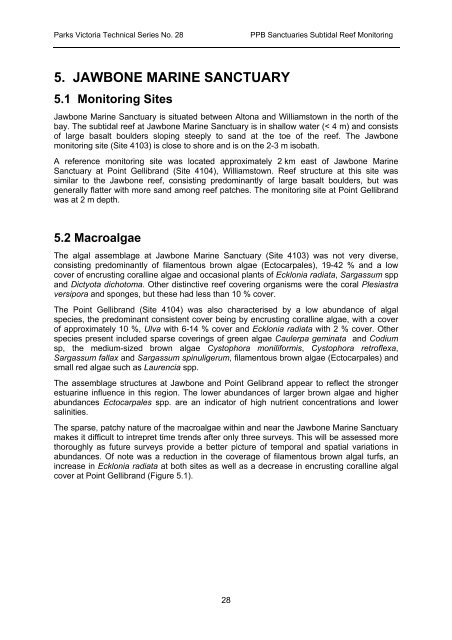Victorian Subtidal Reef Monitoring Program - Parks Victoria
Victorian Subtidal Reef Monitoring Program - Parks Victoria
Victorian Subtidal Reef Monitoring Program - Parks Victoria
You also want an ePaper? Increase the reach of your titles
YUMPU automatically turns print PDFs into web optimized ePapers that Google loves.
<strong>Parks</strong> <strong>Victoria</strong> Technical Series No. 28PPB Sanctuaries <strong>Subtidal</strong> <strong>Reef</strong> <strong>Monitoring</strong>5. JAWBONE MARINE SANCTUARY5.1 <strong>Monitoring</strong> SitesJawbone Marine Sanctuary is situated between Altona and Williamstown in the north of thebay. The subtidal reef at Jawbone Marine Sanctuary is in shallow water (< 4 m) and consistsof large basalt boulders sloping steeply to sand at the toe of the reef. The Jawbonemonitoring site (Site 4103) is close to shore and is on the 2-3 m isobath.A reference monitoring site was located approximately 2 km east of Jawbone MarineSanctuary at Point Gellibrand (Site 4104), Williamstown. <strong>Reef</strong> structure at this site wassimilar to the Jawbone reef, consisting predominantly of large basalt boulders, but wasgenerally flatter with more sand among reef patches. The monitoring site at Point Gellibrandwas at 2 m depth.5.2 MacroalgaeThe algal assemblage at Jawbone Marine Sanctuary (Site 4103) was not very diverse,consisting predominantly of filamentous brown algae (Ectocarpales), 19-42 % and a lowcover of encrusting coralline algae and occasional plants of Ecklonia radiata, Sargassum sppand Dictyota dichotoma. Other distinctive reef covering organisms were the coral Plesiastraversipora and sponges, but these had less than 10 % cover.The Point Gellibrand (Site 4104) was also characterised by a low abundance of algalspecies, the predominant consistent cover being by encrusting coralline algae, with a coverof approximately 10 %, Ulva with 6-14 % cover and Ecklonia radiata with 2 % cover. Otherspecies present included sparse coverings of green algae Caulerpa geminata and Codiumsp, the medium-sized brown algae Cystophora moniliformis, Cystophora retroflexa,Sargassum fallax and Sargassum spinuligerum, filamentous brown algae (Ectocarpales) andsmall red algae such as Laurencia spp.The assemblage structures at Jawbone and Point Gelibrand appear to reflect the strongerestuarine influence in this region. The lower abundances of larger brown algae and higherabundances Ectocarpales spp. are an indicator of high nutrient concentrations and lowersalinities.The sparse, patchy nature of the macroalgae within and near the Jawbone Marine Sanctuarymakes it difficult to intrepret time trends after only three surveys. This will be assessed morethoroughly as future surveys provide a better picture of temporal and spatial variations inabundances. Of note was a reduction in the coverage of filamentous brown algal turfs, anincrease in Ecklonia radiata at both sites as well as a decrease in encrusting coralline algalcover at Point Gellibrand (Figure 5.1).28
















